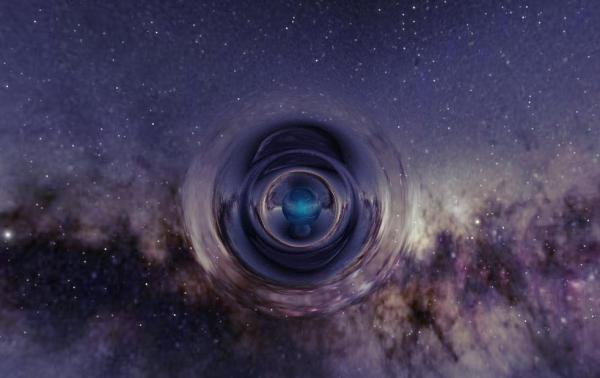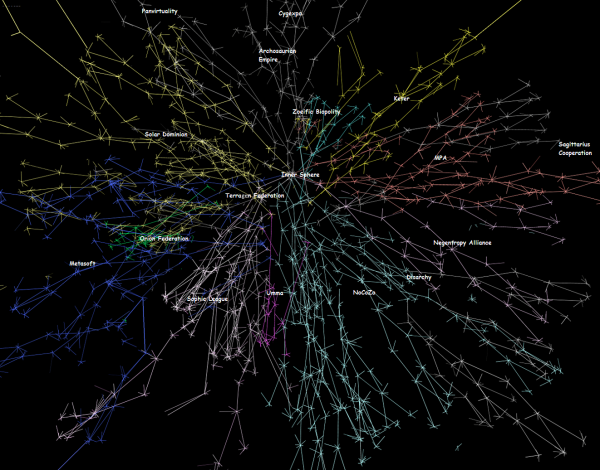BY LETTER
Wormhole Nexus, The
Technology > Application > Communications
Technology > Application > Transportation > Interstellar Transport
Technology > Application > Metric Engineering
Technology > Technology Type or Material > Space-Time Engineering
Technology > Technology Levels > Transapientech / Godtech / Clarketech
Technology > Application > Transportation > Interstellar Transport
Technology > Application > Metric Engineering
Technology > Technology Type or Material > Space-Time Engineering
Technology > Technology Levels > Transapientech / Godtech / Clarketech
 Image from Steve Bowers |
The largest connected system ever built by Terragens, the Wormhole Nexus is a modular and ever expanding network of artificial wormholes, which already spans much of explored space. More than six millennia old, it is still growing at an accelerating pace that shows no signs of abating. While there are several smaller nexi still unconnected to the main network, when one speaks of the Nexus there is no doubt what is being referred to.
The Nexus is more than just a multi-millennial ongoing project, and more than all the billions of physical and exotic matter structures and the quadrillions more support structures, superstructures and maintenance and service systems. It is the symbol of Civilization itself, trumpeted at isolates and xenos and even at other ordinary Terragens, to prove that Sephirotic civilization is the largest, mightiest, greatest empire ever! It allows even the most humble baseline to cross from one end of the known galaxy to the other in only four or five standard years of flatspace travel interspersed with wormhole 'jumps'. It is the circulatory system of the entire Terragen bubble, conveying goods, services, data streams, and sentients of all kinds to where they are needed, or where they wish to go.
And yet, for all of its size, cost, and miraculous technology, the Nexus is something that most beings in the galaxy hardly give a second thought to. It is there, always functioning smoothly, allowing the wonderful Terragen civilization to exist and flourish. It works quietly, in the background, like the Known Net. All sophonts are assured that if they want to go somewhere then they can do so without fear for life or limb. While the vagaries of archailect politics or projects may cause occasional delays, it is a fact that travel through the Nexus is often easier than travel from one end of a planet or megahabitat to another!
 Image from Avengium | |
| Symbolic depictions of the Nexus as a series of fractals | |
Configuration of the Nexus
With some local exceptions, the general configuration of the Nexus is based on a branching network of Relay systems. Few wormholes directly link inhabited system to inhabited system. Instead most link to Relays; clusters of approximately 100 wormholes orbiting within a tenth of a light-year of a suitable star. The Relay star itself is rarely inhabited but instead is heavily re-engineered by supervising archai for material to maintain the Nexus, as well as for their matrioshkas. Maintenance is comprised of: mass for new wormholes (see Weylforge), energy for beamrider transport, gravity tug swarms to maintain the chaotic orbits of so many wormholes and many more routine engineering requirements. The average Relay system connects to inhabited systems, "higher level" Relays and "lower level" Relays in a 90:9:1 ratio. Higher level Relays are more distal systems in the network, further away from Aksijaha; lower level are closer.In some cases Relay systems will connect across branches to linker systems that host a pair of wormholes, each leading to a different Relay. Great care must be taken to set up linker systems in such a way that no CTC forms, the margin of error in many cases is <0.1%. Linker systems are always approximately equidistant between the two Relays and, as with other wormhole links, extend radially from the center of the network. Linker systems are most common in lower level Relays with the 1st Relay Layer host to the first fully connected "ringroad" known as Aksijaha's Halo. The 2nd Relay Layer boasts a nearly complete ring and the 3rd layer has begun to construct more linkers over the past two millennia. Some linker systems are Relays in a more distal level of the Nexus, allowing not only for traffic across the Nexus but simultaneously along it. Aside from alleviating traffic through root systems linkers ensure the Nexus would remain connected even in the event of a major loss of route relays (as was the case in the formation of the Red Star M'Pire). The presence of linker systems at the Nexus core has been dubbed by many as the snowflake configuration.
There are six complete levels to the Nexus with many seventh level Relays under development. In total the Nexus connects approximately ten million systems. Thanks to this, generally only a dozen wormhole crossings are needed to get from one edge of the Nexus to the other, a journey of more than 10,000 lightyears. At lower accelerations a pan-Nexus crossing can take a matter of decades, at higher it can be done in a few short years.
The network of comm-gauge wormholes is also arranged in this manner and often (but not always) overlaps the physical Nexus perfectly. Due to the nature of comm wormholes they can be packed in a much tighter volume, rarely exceeding light seconds in diameter and typically incorporated in the relay system's Dyson swarm. Communication from one side of the Nexus to the other can take less than a standard day, depending on sender/recipient distance to a comm wormhole as well as routing priority.
The Nexus Code
Individual Relays are commonly identified by their Nexus Code, a number indicating their position within the Wormhole Nexus.The numbers 0-9 are assigned to the ten first level Relay systems. Relay 0 is located coreward of Aksijaha. It, along with Relays 1, 2, 3, 4, and 5, serve the galactic plane. Relays 6 and 7 serve the galactic north, while Relays 8 and 9 serve the galactic south.
For each higher level, the number 1-9 is appended onto the designation of the previous Relay system. The level of a given Relay system and access route can thus be determined by its name; for example, Relay 0156 is a fourth level Relay which can be accessed from Aksijaha by traveling through Relay 0, Relay 01, and Relay 015, where Relay 0156 is accessible by transiting the 6th wormhole.
The Nexus Code is also used for locations connected to the Wormhole Nexus, which are identified by a second number placed behind the designation of their local Relay, assigned in order of the creation of their wormhole link. For example, a system connected to Relay 0156 using the tenth wormhole link created from it would have a Nexus Code of 0156-10. Systems connected via side branches and smaller nexi incorporated within the Wormhole Nexus usually have their own naming schemes which are placed after the designation of the system connecting them to the Wormhole Nexus; for example, V998 Tauri's Nexus Code number is 4-1-TN2.
Sectors
A sector is a volume of space connected to the Wormhole Nexus by a Relay, and consists of every star system directly linked to the Relay as well as any systems or other inhabited volumes in proximity to them. On average, each sector spans some 370,000 cubic light-years, and contains approximately 1,000 systems.Sectors are usually referred to by their Relay system Nexus Code (e.g., Sector 0156), although many civilizations have named their own sectors after locally notable historical, galactographic, or cultural artifacts - which may become more popular than the official Nexus designation.
Other Nexi
The first wormhole network to be discovered was the Taurus Nexus, created by a very early a-human transapient civilisation in the First Federation era. Later, parts of the alien nexus built by the Tunh were discovered, although the component parts of this nexus have mostly disappeared and the few that remain have drifted far apart. Other entirely independent nexi have been built, such as the Diamond Nexus, the Panvirtuality Nexus, and the later Lirantiq nexus all of which have since been connected to the main network.Wormholes come in two main kinds:
Traversable wormholes, which use a modified Morris-Thorne-Kuhfittig metric. These are very large: traversable wormholes are consistently 327 Astronomical Units (A.U.s) in radius from the region of flat-space to the wormhole mouth. This kind of wormhole uses a relatively small quantity of negative (exotic) ANEC-violating energy. This is the kind of wormhole often referred to as a stargate.
Hayward class wormholes which are much smaller, but use a much larger amount of negative (exotic) ANEC-violating energy. They are only useful for transmitting em-beams containing data, but this data transfer is very important to the existence of civilisation in the Terragen Sphere.
 Image from Steve Bowers | |
| Overview of the Wormhole Nexus in the Middle Regions and Inner Sphere | |
Related Articles
- Aksijaha (Alpha Lyrae)
- Causal Fortress
- Chronology Protection - Text by Anders Sandberg
The universe seems to counteract attempts to produce time machines, for example due to Visser decay and related vacuum phenomena undermining other forms of time communication. Although the strict Chronology Protection Conjecture by the information age physicist Hawking was subsequently disproved, the chronology protection theorems of Lang, Picard and Joel-5 showed that this tendency can be explained from the consistency theorems, information physics and (eventually) vacuum physics. - Fargate, The
- God Web, The
- Grapeship Ownership
- Grapeships
- High Road, The
- Known Net, The
- Kuranaba Gate
- Linelayer
- Lirantiq Nexus
- Nexus, The - Text by Orion's Arm Editors
The common term for the Wormhole Nexus. - Sagittarius Project - Text by Anders Sandberg
Major exploration project backed by a number of research and colonization megacorporations in the Establishment and early Consolidation era. The Sagittarius Project attempted to set up wormhole links to the Sagittarius arm and continue inwards to the galactic core. Over time, the Project developed into a megacorp-house like most others (eventually becoming the Sagittarius Sphere), and the thrust towards the core was replaced by exploiting the many new worlds found in the Sagittarius arm. Some research vessels are still on their way towards the core, and are expected back in a few millennia. - Stargate
- Taurus Nexus
- Visser Effect
- W-Brain, Distributed Wormhole Brain
- Weylforge
- Wormhole Bus
- Wormhole Termini
- Wormholes - A Layman's Guide
- Wormholes - Cultural Factors
Appears in Topics
| Communications | Interstellar Transport | Metric Engineering |
| Space-Time Engineering | Transapientech / Godtech / Clarketech |
Development Notes
Text by Anders Sandberg and M. Alan Kazlev
Minor update by The Astronomer 2021. Minor update by Todd Drashner and Dangerous Safety 2022.
Initially published on 03 October 2001.
See also: Wormholes FAQ
The exact distance depends on the mass ratio and effective transmission of energy between wormholes, but for equal mass wormholes with no obstructions and a spherically symmetric explosion, it can be roughly approximated as follows.
In order for a collapse to occur, more than 1% the mass of the wormhole needs to enter its Transition region. This requires that the Transition region covers more than 1%/0.7 = 1.4% of the sky of the detonating wormhole. By dividing the cross-sectional area of a traversable wormhole by 1.4%, we can find the area of a spherical surface at the distance where the transition region of the wormhole covers 1.4% of the sky, and using that we can calculate the maximum separation for chain collapses.
- Traversable wormhole cross-sectional area = pi*327^2 = 335927 AU^2
- Total sphere area = 335927/0.014 = 23994786 AU^2
- Separation = (23994786/4pi)^(0.5) = 1382 AU
So from this, it can be shown that if wormhole mouths of equal mass are closer together than 1382 AU, then the collapse of one will trigger the collapse of the other.
Relay systems in the Terragen Sphere are designed to have a radius of one-tenth of a light-year (6324 AU), with a total volume of ~1.06e12 cubic AU. From this, it is possible to calculate that a Relay system can contain 768 'safe volumes', each 1382 AU (radius of 691 AU) across.
Since each Relay only contains a maximum of 100 wormholes, this allows ample room to make the Relay 'inherently safe' against chain reactions caused by the implosion of any one wormhole.
Added 'The Nexus Code' and 'Sector' sections (2023-02-28, by The Astronomer)
Minor update by The Astronomer 2021. Minor update by Todd Drashner and Dangerous Safety 2022.
Initially published on 03 October 2001.
See also: Wormholes FAQ
Some Notes on Nexus Design and Wormhole Safety
When a wormhole collapses, it produces a black hole with about 30% of its original mass, with the remaining 70% of its mass-energy being radiating outward. If another wormhole is close enough, then this may be sufficient to cause it to collapse as well, which may in turn trigger yet more collapses.The exact distance depends on the mass ratio and effective transmission of energy between wormholes, but for equal mass wormholes with no obstructions and a spherically symmetric explosion, it can be roughly approximated as follows.
In order for a collapse to occur, more than 1% the mass of the wormhole needs to enter its Transition region. This requires that the Transition region covers more than 1%/0.7 = 1.4% of the sky of the detonating wormhole. By dividing the cross-sectional area of a traversable wormhole by 1.4%, we can find the area of a spherical surface at the distance where the transition region of the wormhole covers 1.4% of the sky, and using that we can calculate the maximum separation for chain collapses.
- Traversable wormhole cross-sectional area = pi*327^2 = 335927 AU^2
- Total sphere area = 335927/0.014 = 23994786 AU^2
- Separation = (23994786/4pi)^(0.5) = 1382 AU
So from this, it can be shown that if wormhole mouths of equal mass are closer together than 1382 AU, then the collapse of one will trigger the collapse of the other.
Relay systems in the Terragen Sphere are designed to have a radius of one-tenth of a light-year (6324 AU), with a total volume of ~1.06e12 cubic AU. From this, it is possible to calculate that a Relay system can contain 768 'safe volumes', each 1382 AU (radius of 691 AU) across.
Since each Relay only contains a maximum of 100 wormholes, this allows ample room to make the Relay 'inherently safe' against chain reactions caused by the implosion of any one wormhole.
Added 'The Nexus Code' and 'Sector' sections (2023-02-28, by The Astronomer)






